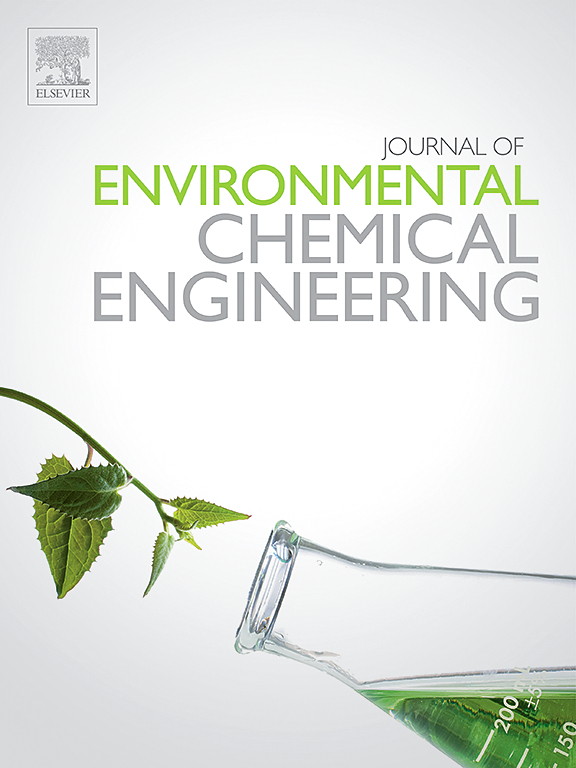Ammonia-assisted Cu dispersion in NaY zeolite: Enhanced H2S removal and regeneration insights
IF 7.4
2区 工程技术
Q1 ENGINEERING, CHEMICAL
引用次数: 0
Abstract
Ammonia-assisted copper dispersion offers a promising strategy to enhance the performance of zeolite-based sorbents for hydrogen sulfide (H2S) removal under challenging industrial conditions. In this study, copper-exchanged NaY zeolite sorbents (CuAY) were synthesized via an ammonia-assisted ion exchange method and evaluated for low-temperature H2S adsorption in humid blast furnace gas (BFG). The formation of [Cu(NH3)4]2+ complexes facilitated uniform copper dispersion and prevented agglomeration, thereby preserving the zeolite’s microporous structure. The optimized CuAY sorbent achieved a breakthrough sulfur capacity of 3.11 g S/100 g at 60 °C with 5 vol% H2O, exceeding that of conventional CuY by 60 %. Moderate humidity was found to enhance H2S uptake, while excessive moisture led to pore blockage. Regeneration studies confirmed good stability over multiple cycles. These findings highlight the potential of ammonia-assisted CuAY sorbents as efficient and regenerable materials for environmental desulfurization. Future research will focus on improving long-term regeneration performance and scaling up this technology for industrial applications.
氨辅助Cu在NaY沸石中的分散:增强H2S去除和再生的见解
在具有挑战性的工业条件下,氨辅助铜分散体是一种很有前途的策略,可以提高沸石基吸附剂去除硫化氢(H2S)的性能。本研究采用氨辅助离子交换法合成了铜交换型NaY沸石吸附剂(CuAY),并对其在湿高炉气(BFG)中的低温H2S吸附性能进行了评价。[Cu(NH3)4]2+配合物的形成促进了铜的均匀分散,防止了团聚,从而保持了沸石的微孔结构。优化后的CuAY吸附剂在60℃、5 vol% H2O条件下的硫容达到了3.11 g S/100 g,比常规CuY的硫容提高了60 %。适度的湿度可以促进H2S的吸收,而过度的湿度会导致孔隙堵塞。再生研究证实在多个循环中具有良好的稳定性。这些发现突出了氨辅助CuAY吸附剂作为高效可再生环境脱硫材料的潜力。未来的研究将集中在提高长期再生性能和扩大该技术的工业应用上。
本文章由计算机程序翻译,如有差异,请以英文原文为准。
求助全文
约1分钟内获得全文
求助全文
来源期刊

Journal of Environmental Chemical Engineering
Environmental Science-Pollution
CiteScore
11.40
自引率
6.50%
发文量
2017
审稿时长
27 days
期刊介绍:
The Journal of Environmental Chemical Engineering (JECE) serves as a platform for the dissemination of original and innovative research focusing on the advancement of environmentally-friendly, sustainable technologies. JECE emphasizes the transition towards a carbon-neutral circular economy and a self-sufficient bio-based economy. Topics covered include soil, water, wastewater, and air decontamination; pollution monitoring, prevention, and control; advanced analytics, sensors, impact and risk assessment methodologies in environmental chemical engineering; resource recovery (water, nutrients, materials, energy); industrial ecology; valorization of waste streams; waste management (including e-waste); climate-water-energy-food nexus; novel materials for environmental, chemical, and energy applications; sustainability and environmental safety; water digitalization, water data science, and machine learning; process integration and intensification; recent developments in green chemistry for synthesis, catalysis, and energy; and original research on contaminants of emerging concern, persistent chemicals, and priority substances, including microplastics, nanoplastics, nanomaterials, micropollutants, antimicrobial resistance genes, and emerging pathogens (viruses, bacteria, parasites) of environmental significance.
 求助内容:
求助内容: 应助结果提醒方式:
应助结果提醒方式:


